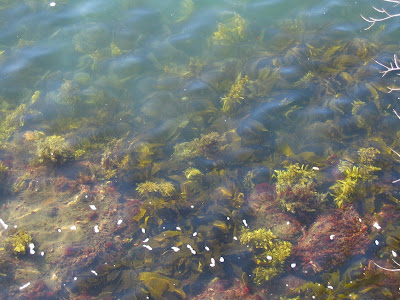The Cryptic House (P4P*)

This might one day be our "Octopus's Garden", just off Mrs Macquaries Point. For now, our Cryptogam House is a reminder of the alga, fungi, mosses and other smaller 'plants' that live in and around our botanic garden.
Firstly, we need to clear up the confusion between ‘cryptogram’ and ‘cryptogam’. The former is a code that requires deciphering (i.e. cryptic writing), the latter a group of plants and plant-like organisms whose sexual ways were once obscure (i.e. cryptic marriage). The term cryptogam is itself a little cryptogramic.
So why do we have a house dedicated to things with obscure sex? Well most of the botanic garden displays the beauty and wonder of ‘phanerogams’, the seed-bearing plants. In these plants you can see the sexual organs – they are the mostly the pretty flowers that attract the attention of birds, bees and us, but also conifers and the like.
The category Cryptogamia was devised by Carl Linnaeus in the 18th century, but the definitions have changed over time. Ferns, for example, have been included in either cryptogams or phanerogams. Mosses, algae and fungi have always been considered cryptogams.
But now that we understand the full complexity of life on earth, these terms aren’t very helpful, except as a link to the history of science and our botanic garden.
Mosses are grouped together with the flowering plants, conifers, ferns and green algae. The rest of the algae are incredibly diverse and spread throughout the tree of life. The fungi turn out to be more closely related to animals than to plants.
The anachronistic Cryptogam House in the Royal Botanic Gardens started life in 1921 as the Aquatic House, holding glass display tanks of water plants. It evolved into a cryptogram display, showing off mosses and ferns – plants that generally like moist but not fully aquatic surrounds.
These days it is used by our Education staff for potting up plants with some of the 24,000 school children who visit the botanic gardens for classes and excursions.
We have plans for opening up more of our glasshouses and turning a couple of them into large aquatic tanks to display water plants. You can see bigger cryptogams in the Fernery, next to the Cryptogam House.
I’m also keen to promote what might be called the ‘Octopus’s Garden’ off Mrs Macquaries Point. There is a natural aquatic garden under the sea and we are exploring ways to view and interpret the seaweeds on the rocky shores of Sydney Harbour.
So why do we have a house dedicated to things with obscure sex? Well most of the botanic garden displays the beauty and wonder of ‘phanerogams’, the seed-bearing plants. In these plants you can see the sexual organs – they are the mostly the pretty flowers that attract the attention of birds, bees and us, but also conifers and the like.
The category Cryptogamia was devised by Carl Linnaeus in the 18th century, but the definitions have changed over time. Ferns, for example, have been included in either cryptogams or phanerogams. Mosses, algae and fungi have always been considered cryptogams.
But now that we understand the full complexity of life on earth, these terms aren’t very helpful, except as a link to the history of science and our botanic garden.
Mosses are grouped together with the flowering plants, conifers, ferns and green algae. The rest of the algae are incredibly diverse and spread throughout the tree of life. The fungi turn out to be more closely related to animals than to plants.
The anachronistic Cryptogam House in the Royal Botanic Gardens started life in 1921 as the Aquatic House, holding glass display tanks of water plants. It evolved into a cryptogram display, showing off mosses and ferns – plants that generally like moist but not fully aquatic surrounds.
These days it is used by our Education staff for potting up plants with some of the 24,000 school children who visit the botanic gardens for classes and excursions.
We have plans for opening up more of our glasshouses and turning a couple of them into large aquatic tanks to display water plants. You can see bigger cryptogams in the Fernery, next to the Cryptogam House.
I’m also keen to promote what might be called the ‘Octopus’s Garden’ off Mrs Macquaries Point. There is a natural aquatic garden under the sea and we are exploring ways to view and interpret the seaweeds on the rocky shores of Sydney Harbour.
*This Passion for Plants posting will also appear on the ABC Sydney website (possibly under 'gardening'), and is the gist of my radio interview with Simon Marnie on Saturday Morning sometime between 9-10 am on 702AM.
Comments